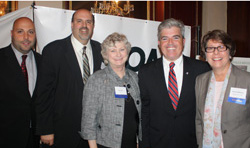
Below, please find a summary of our TOD conference in September. We apologize for the delay in reporting on this important event. Better late than never! Thanks to all who attended. Long Island leaders gather in Hicksville to discuss future of transit-oriented developmentOn Wednesday, September 15th, 300 Long Islanders gathered at Antun’s in Hicksville for Long Island's first “Planning for Transit-Oriented Development” conference. Attendees included elected officials, developers, advocacy groups, business leaders, civic associations and many others. The event was organized by Vision Long Island, the Permanent Citizens Advisory Committee to the MTA, the LIRR Commuter Council, the Long Island Section of the American Planning Association and Tri-State Transportation Campaign.
We extend a special thanks to event sponsors VHB and AECOM. A copy of G. B. Arrington's presentation is available here. A copy of Vivian Baker's presentation is also available online here.
(left- NYS Sen. Craig Johnson; right- Mineola Mayor Jack Martins and LIRR's Elisa Picca)
(left- Town of Brookhaven's Paul Rogalle and VHBs Bob Eschbacher; right - PCAC's Dr. Jan Wells, AECOM's Deborah Howes and PCAC's Ellyn Shannon) (left - Office of NYS Comptroller Tom DiNapoli's Joe Gallante; right - Northwest Gardens Civic Association's Joel Burse) |
|
For more information about Vision Long Island, visit visionlongisland.org or contact us at: |
 Featured speakers included MTA/LIRR President Helena Williams, NYS Comptroller Tom DiNapoli, Joe Galante and John Stouffer from the Comptroller's Office, Town of Babylon Supervisor Steve Bellone, Place Making Group/Parsons Brickerhoff’s G.B. Arrington, NJ TRANSIT’s Vivian Baker, One Region Fund’s John McNally, Village of Mineola Mayor Jack Martins, Hicksville Chamber of Commerce President Lionel Chitty, VHB’s Bob Eschbacher, Tri-State Transportation Campaign’s Ryan Lynch, LIRR’s Elisa Picca and NYS Senator Craig Johnson. Introductory speakers and moderators included APA-LI’s David Berg, PCAC’s Dr. Jan Wells and Vision Long Island’s Eric Alexander.
Featured speakers included MTA/LIRR President Helena Williams, NYS Comptroller Tom DiNapoli, Joe Galante and John Stouffer from the Comptroller's Office, Town of Babylon Supervisor Steve Bellone, Place Making Group/Parsons Brickerhoff’s G.B. Arrington, NJ TRANSIT’s Vivian Baker, One Region Fund’s John McNally, Village of Mineola Mayor Jack Martins, Hicksville Chamber of Commerce President Lionel Chitty, VHB’s Bob Eschbacher, Tri-State Transportation Campaign’s Ryan Lynch, LIRR’s Elisa Picca and NYS Senator Craig Johnson. Introductory speakers and moderators included APA-LI’s David Berg, PCAC’s Dr. Jan Wells and Vision Long Island’s Eric Alexander.